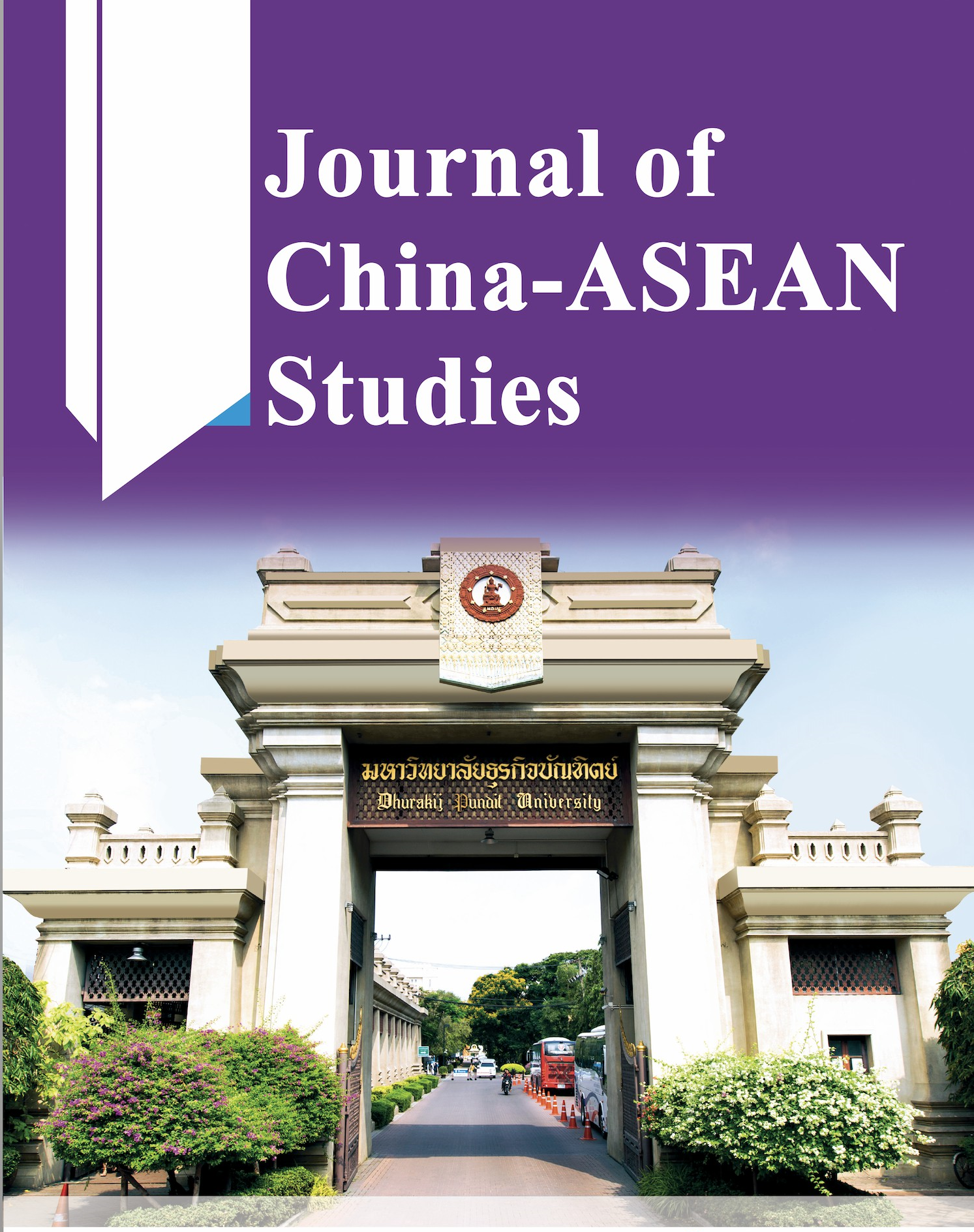Investigation and Research into Chinese Translation Errors in the names of dishes in Thai Cuisine: This study focuses on the menu of the restaurants in Siam Square business district as an example
Keywords:
Chinese Translation of Thai Food Names, Thai-Chinese Translation, Translation ErrorsAbstract
There are more and more cultural studies on the names of cuisines in academia, but few
studies have focused on the Chinese translations of Thai cuisines precisely, and the study of
their translation errors is still a new field. Under the guidance of translation theory, the survey
samples are analysed item by item, taking into account the characteristics of Chinese and Thai
cuisine names, categorising the problems of lexical errors, grammatical errors and aesthetic
errors, and suggesting that the causes of translation errors include the non-equivalence of
language, secondary translation errors, over-reliance on machine translation and lack of
professionals. translation suggestions were puts forward from three aspects: vocabulary,
grammar and aesthetics. On the basis of these suggestions, it should be beneficial to suggest
that government authorities provide regulation and support to the cuisine industry, the
education circle cultivates more Chinese language professionals, the cuisine community
strengthens Chinese language training, the AI translation software optimises its system, and
consumers correct errors intentionally
References
蔡欣洁、文炳(2021)。汉译英机器翻译错误类型统计分析——以外宣文本汉译英为例。浙江理工大学学报(社会科学版),2(03),1-8。https://chn.oversea.cnki.net/KCMS/detail/detail.aspx?dbcode=CJFD&dbname=CJFDLAST2021&filename=ZLGS202102006&uniplatform=OVERSEA&v=Z7rIzXKoo-KwhUzr9niWVaZZ7xkOAx52_eq-X1ytRwRqq68KCa0uKkkLzVGJC_-2
陈徐(2021)。落实字词,规范翻译——例谈文言文阅读与翻译的“三原则”。教学考试(01),59-61。doi: CNKI:SUN:JXKS.0.2021-01-023.
段兆会、张允(2019)。目的论视角下中文菜单翻译现状及策略。黑龙江教育学院学报,38(07),130-132。doi: CNKI:SUN:HLJB.0.2019-07-041.
郭娟、曾二青(2020)。跨文化传播视角下英语翻译技巧及方法——评《跨文化传播视角下的英语翻译策略与技巧》。中国广播电视学刊(12),134。doi:CNKI:SUN:GDXK.0.2020-12-062.
何妍(2020)。试论经济学视角下的赴泰留学。知识经济(12),28-29。doi:10.15880/j.cnki.zsjj.2020.12.015.
金昌珍(2020)。翻译中概念范畴的分类和相互关联性——以翻译理论、策略、方法、技巧为例。中国朝鲜语文(04),59-66。doi: CNKI:SUN:CXYW.0.2020-04-007.
黎阳阳(2020)。赴泰中国留学生消费情况调查——以广西外国语学院为例。青年与社会(13),161-162。doi: CNKI:SUN:QNSH.0.2020-13-073.
李慧珊(2017)。泰国菜名的汉译方法与策略。北方文学(17),106。doi:CNKI:SUN:BFWX.0.2017-17-081.
李影璇(2021)。基于课堂观察的科技翻译错误分析研究。文化创新比较研究,5(01),150-154。doi: CNKI:SUN:WCBJ.0.2021-01-051.
刘宏(2020)。西奥·赫曼斯翻译理论研究[博士学位论文,湖南师范大学]。中国博士论文数据库。https://kns.cnki.net/KCMS/detail/detail.aspx?dbname=CDFDLAST2021&filename=1021513281.nh
吕红丽(2021)。新时期旅游英语翻译的技巧和方法探析。湖北开放职业学院学报,34(04),183-184。doi: CNKI:SUN:HBHS.0.2021-04-084.
石赵佳(2021)。机器翻译的错误类型分析与译后编辑策略[硕士学位论文,上海外国语大学]。中国硕士论文数据库https://kns.cnki.net/KCMS/detail/detail.aspx?dbname=CMFD202101&filename=1021009109.nh
谭华(2018)。中西饮食文化比较与中餐菜名翻译标准。黑龙江教育学院学报,37(02),120-123。doi: CNKI:SUN:HLJB.0.2018-02-038.
王涵(2015)。对中国菜名英译现状的思考及其翻译对策。艺术科技(08),291-292。doi: CNKI:SUN:YSKK.0.2015-08-251.
徐盛桓(1995)。语言美学论纲。外语学刊(黑龙江大学学报)(02),1-8。doi:10.16263/j.cnki.23-1071/h.1995.02.001.
许薇(2016)。中文菜单的翻译现状和策略探究。海外英语(08),129-130。doi:CNKI:SUN:HLJB.0.2019-07-041.
许钧、穆雷(2009)。翻译学概论。译林出版社。尹飞舟、王佳娣(2021)。中华文化走出去的理论新视角:翻译传播过程的四种模式。求索(02),44-50。doi:10.16059/j.cnki.cn43-1008/c.2021.02.004.
张鞠成(2020)。现实与想象:赴泰旅游风险的社会建构[硕士学位论文,华侨大学]中国硕士论文数据库。https://kns.cnki.net/KCMS/detail/detail.aspx?dbname=CMFD202101&filename=1020323866.nh
张昱、方嘉莹.(2020).翻译作为跨文化交际的媒介:以澳门菜单为例 [论文集发表]。基于中葡平台的创新性发展研究——2020年中国与葡语系国家发展研究国际会议,澳门,中国。DOI:10.26914/c.cnkihy.2020.051563。
郑燕平(2011)。论全球背景下语篇翻译的原则[博士学位论文,上海外国语大学]。中国博士论文数据库。https://kns.cnki.net/KCMS/detail/detail.aspx?dbname=CDFD1214&filename=1012251562.nh
Brown, H. D. ( 2000).Principles of Language Learning and Teaching. Long man Inc.Buddawong, N., & Surahan, S. (2021). A Study of Strategies for Translating Thai Food Names into Chinese: A Case Study of Thai restaurant in Chengdu. China Humanities and Social Sciences Journal,12(1),171-172.https://so01.tci-thaijo.org/index.php/humanjubru/article/view/245688/167220
Pouget, C. F. (2000). Are Menu Translations Getting Worse?: Restaurant Menus in English in the Tarragona Area. Target. International Journal of Translation Studies, 12(2), 323-332.https://doi.org/10.1075/target.12.2.08fal
Corder, S. P. (1967). The significance of learner's errors. IRAL: International Review of Applied Linguistics in Language Teaching, 5(4), 161–170.https://doi.org/10.1515/iral.1967.5.1-4.161
Sinthawornkul, S. (2004). Thai Ways of E ating and B eliefs as R eflected in the N ames of ThaiFoods used in Traditional Ceremonies and Festivals [Master Degree Thesis, Chulalongkorn University]. Thai thesis database. DOI: https://doi.nrct.go.th/ListDoi/listDetail?Resolve_DOI=10.14457/CU.the.2004.263






